
The Large Magellanic Cloud (LMC) is a satellite galaxy of the Milky Way. At a distance of around 50 kiloparsecs (160 kly), the LMC is the second- or third-closest galaxy to the Milky Way, after the Sagittarius Dwarf Spheroidal (c. 16 kpc (52 kly) away) and the possible dwarf irregular galaxy called the Canis Major Overdensity. Based on the D25 isophote at the B-band (445 nm wavelength of light), the Large Magellanic Cloud is about 9.86 kpc (32.2 kly) across. It is roughly one-hundredth the mass of the Milky Way and is the fourth-largest galaxy in the Local Group, after the Andromeda Galaxy (M31), the Milky Way, and the Triangulum Galaxy (M33).
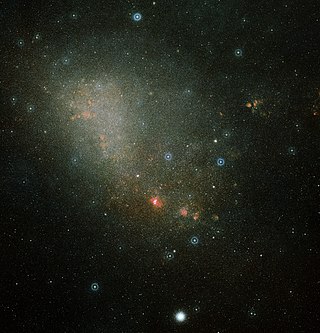
The Small Magellanic Cloud (SMC), or Nubecula Minor, is a dwarf galaxy near the Milky Way. Classified as a dwarf irregular galaxy, the SMC has a D25 isophotal diameter of about 5.78 kiloparsecs (18,900 light-years), and contains several hundred million stars. It has a total mass of approximately 7 billion solar masses. At a distance of about 200,000 light-years, the SMC is among the nearest intergalactic neighbors of the Milky Way and is one of the most distant objects visible to the naked eye.

Wolf–Rayet stars, often abbreviated as WR stars, are a rare heterogeneous set of stars with unusual spectra showing prominent broad emission lines of ionised helium and highly ionised nitrogen or carbon. The spectra indicate very high surface enhancement of heavy elements, depletion of hydrogen, and strong stellar winds. The surface temperatures of known Wolf–Rayet stars range from 20,000 K to around 210,000 K, hotter than almost all other kinds of stars. They were previously called W-type stars referring to their spectral classification.
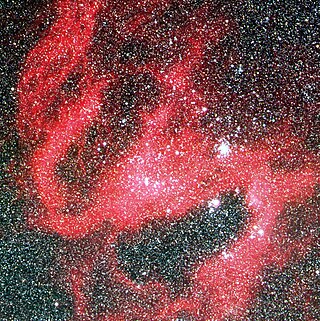
S Doradus is one of the brightest stars in the Large Magellanic Cloud (LMC), a satellite galaxy of the Milky Way, located roughly 160,000 light-years away. The star is a luminous blue variable, and one of the most luminous stars known, having a luminosity varying widely above and below 1,000,000 times the luminosity of the Sun, although it is too far away to be seen with the naked eye.
In astronomy, extinction is the absorption and scattering of electromagnetic radiation by dust and gas between an emitting astronomical object and the observer. Interstellar extinction was first documented as such in 1930 by Robert Julius Trumpler. However, its effects had been noted in 1847 by Friedrich Georg Wilhelm von Struve, and its effect on the colors of stars had been observed by a number of individuals who did not connect it with the general presence of galactic dust. For stars that lie near the plane of the Milky Way and are within a few thousand parsecs of the Earth, extinction in the visual band of frequencies is roughly 1.8 magnitudes per kiloparsec.

A superbubble or supershell is a cavity which is hundreds of light years across and is populated with hot (106 K) gas atoms, less dense than the surrounding interstellar medium, blown against that medium and carved out by multiple supernovae and stellar winds. The winds, passage and gravity of newly born stars strip superbubbles of any other dust or gas. The Solar System lies near the center of an old superbubble, known as the Local Bubble, whose boundaries can be traced by a sudden rise in dust extinction of exterior stars at distances greater than a few hundred light years.

The Magellanic Bridge (MBR) is a stream of neutral hydrogen that links the two Magellanic Clouds, with a few known stars inside it. It should not be confused with the Magellanic Stream, which links the Magellanic Clouds to the Milky Way. It was discovered in 1963 by J. V. Hindman et al.
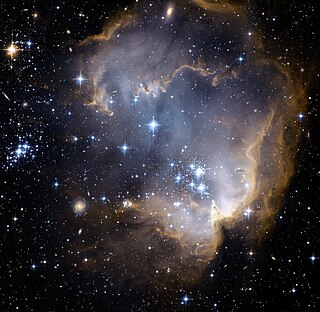
NGC 602 is a young, bright open cluster of stars located in the Small Magellanic Cloud (SMC), a satellite galaxy to the Milky Way. It is embedded in a nebula known as N90.

LH 95 is a modestly sized stellar nursery in the Large Magellanic Cloud. It is related to the HII-region LHA 120-N 55, that is, a region of hydrogen ionized by the bright stars of LH 95.

HD 269810 is a blue giant star in the Large Magellanic Cloud. It is one of the most massive and most luminous stars known, and one of only a handful of stars with the spectral type O2.

WOH G64 is an unusual red supergiant (RSG) star in the Large Magellanic Cloud (LMC) satellite galaxy in the southern constellation of Dorado. It is one of the largest known stars, being described as possibly being the largest star known. It is also one of the most luminous and massive red supergiants, with a radius calculated to be around 1,540 times that of the Sun (R☉) and a luminosity around 282,000 times the solar luminosity (L☉).
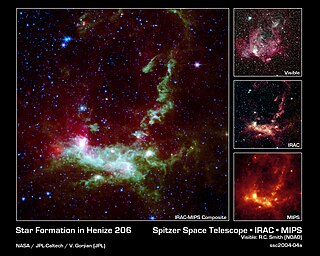
Henize 206 is a nebula in the Large Magellanic Cloud. This luminous cloud of gas and dust houses a cluster of newborn stars. Although Henize 206 was first catalogued in the 1950s, it was reported in NASA press releases in March 2004, for showing several example images generated from the various infrared cameras on the Spitzer Space Telescope launched in August 2003.

AB7, also known as SMC WR7, is a binary star in the Small Magellanic Cloud. A Wolf–Rayet star and a supergiant companion of spectral type O orbit in a period of 19.56 days. The system is surrounded by a ring-shaped nebula known as a bubble nebula.
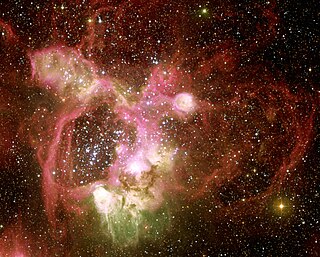
N44 is an emission nebula with superbubble structure located in the Large Magellanic Cloud, a satellite galaxy of the Milky Way in the constellation Dorado. Originally catalogued in Karl Henize's "Catalogue of H-alpha emission stars and nebulae in the Magellanic Clouds" of 1956, it is approximately 1,000 light-years wide and 160,000-170,000 light-years distant. N44 has a smaller bubble structure inside known as N44F. The superbubble structure of N44 itself is shaped by the radiation pressure of a 40-star group located near its center; the stars are blue-white, very luminous, and incredibly powerful. N44F has been shaped in a similar manner; it has a hot, massive central star with an unusually powerful stellar wind that moves at 7 million kilometers per hour. This is because it loses material at 100 million times the rate of the Sun, or approximately 1,000,000,000,000,000 tons per year. However, varying density in the N44 nebula has caused the formation of several dust pillars that may conceal star formation. This variable density is likely caused by previous supernovae in the vicinity of N44; many of the stars that have shaped it will eventually also end as supernovae. The past effects of supernovae are also confirmed by the fact that N44 emits x-rays.

LMC195-1 is a Wolf–Rayet star located in the Large Magellanic Cloud (LMC). It is an extremely rare member of the WO oxygen sequence, at WO2 the hottest known in the LMC. It is likely to be one of the hottest stars known.

N119 is a spiral-shaped H II region in the Large Magellanic Cloud. Its dimensions are large, at 131 x 175 pc. It contains several luminous stars including S Doradus, LH41-1042, and LMC195-1. Its peculiar S-shaped structure is difficult to explain with classical models.
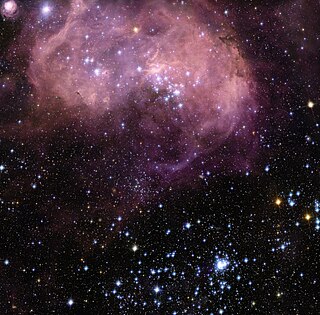
N11 is the brightest emission nebula in the north-west part of the Large Magellanic Cloud in the Dorado constellation. The N11 complex is the second largest H II region of that galaxy, the largest being the Tarantula Nebula. It covers an area approximately 6 arc minutes across. It has an elliptical shape and consists of a large bubble, generally clear interstellar area, surrounded by nine large nebulae. It was named by Karl Henize in 1956.
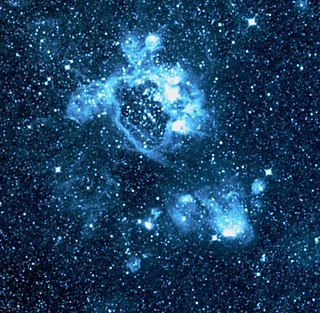
N41 is an emission nebula in the north part of the Large Magellanic Cloud in the Dorado constellation. Originally catalogued in Karl Henize's "Catalogue of H-alpha emission stars and nebulae in the Magellanic Clouds" of 1956, it is approximately 100 light-years wide and 160,000-170,000 light-years distant.

WOH S264 is a large, highly luminous red supergiant star in the Large Magellanic Cloud.

Henize 70 (N70) is a faint emission nebula and superbubble located in the Large Magellanic Cloud. It is located in the constellation of Dorado.

















